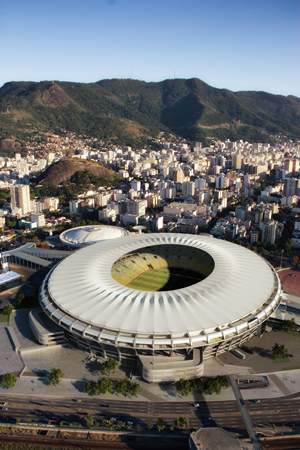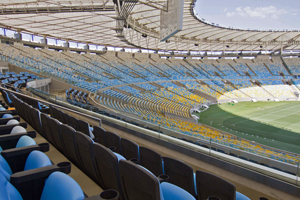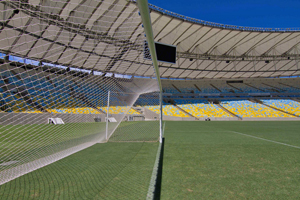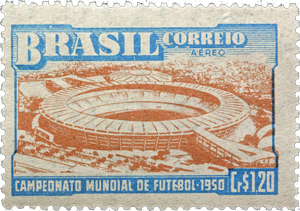 |
 |
 |
 |
 |
 |
| |
 |
|
 |
 |
 |
  |
  |
 |
 |
 |
 |
|
|
 |
|
 |
 |
 |
BUILDING |
 |
|
 |
|
 |
 |
 |
| |
 |
| 
 |
Estádio Jornalista Mário Filho | Estádio municipal do Maracanã
Maracanã Stadium |
|
 |
 |
 |
 |
DESIGNER |
 |
|
|
 |
|
 |
 |
 |
| |
 |
|
 |
 |
 |
 |
DESCRIPTION |
 |
|
|
 |
|
 |
 |
 |
| . |
 |
|
 |
 The differential conducted by Fernandes Associates Architects in the Maracanã Arena project was to make the public stage toppled in one of the most modern and efficient in the world keeping its main features built during 60 years of history and symbolism Arenas. The differential conducted by Fernandes Associates Architects in the Maracanã Arena project was to make the public stage toppled in one of the most modern and efficient in the world keeping its main features built during 60 years of history and symbolism Arenas.
A new Maracanã was "born" within the former, so as not to overwrite the existing, but rather renew it. Thus, some structures no longer exist to give rise to other new elements were incorporated and the remaining spaces were recovered.
 The main changes occurred in the design of the stands, where new structures are designed to meet the ideal conditions of visibility, safety and comfort. All related services such as bars and toilets, structures were completely rebuilt to the highest standards . The main changes occurred in the design of the stands, where new structures are designed to meet the ideal conditions of visibility, safety and comfort. All related services such as bars and toilets, structures were completely rebuilt to the highest standards .
One of the highlights of the renovation of the stadium is the strong presence of small and huge translucent cover, floating light, almost without touching the existing structure, capping and protecting the old stadium , passing the visitor an invaluable experience . The project, which has authored the German office Bergermann Schlaich und Partner ( SBP ) will enable the implementation of a PV ring on the metal structure that will support the new coverage tensioned canvas, generating clean energy equivalent to the consumption of 240 households and avoiding the emission of 2,560 tons of CO2 into the atmosphere .
The front was preserved and, regardless of where it is seen, outside the Maracanã remains largely intact. Not even the new coverage brings visual impact and you cannot catch sight of it from the outside. Were still kept the main internal circulation and its relation to the existing structure, such as pillars, ceiling, opening , among others .
In addition, the built up area which was 86 thousand square meters, has been expanded and now have approximately 160 thousand square meters .
This is one of the the most successful Fernandes project because they had the challenge to modernize and preserve the Maracanã keeping your entire popular representation and making the stadium built for the 1950 World Cup once again be one of the main stadiums of the world for the next 30 or 40 years .
Viewers will experience the unique and special relationship between the new and the old way. |
|
 |
 |
 |
|
 |
|
| The chairs of the Maracana |
 |
|
 |
 Typically, the design layout and the colors of the chairs of the stadiums are more aesthetic than functional, and in most cases, is associated with symbolic issues like the color of the team, the flag of the country or the city and even the names figures and symbols. Typically, the design layout and the colors of the chairs of the stadiums are more aesthetic than functional, and in most cases, is associated with symbolic issues like the color of the team, the flag of the country or the city and even the names figures and symbols.
The division of color is an important tool in setting the bleachers and its separation into blocks, rings or sectors creates a very rigid demarcation giving the impression of "blending" of the bleachers. All these features diminish the joy and unity of all subjective, leaving implicitly associating values as expensive and cheap and / or good or bad.
The idea of the project was to take advantage of this distribution to aggregate together and the feeling of togetherness.
The colors were merged between the chairs promoting a smoother transition, besides the impression filled bleachers, even when capacity is not full and the audience at random positions. The use of this "mix" of various colors and decreases the perception of empty spaces. In the case of Maracanã, the choice was almost obvious due to its role as the national stadium. The stadium is the only Rio de Janeiro, but Brazil as a whole. The chosen (yellow, blue and white) plus cheerful colors also represent the national colors. The green field was used to complete the missing color, and thus have the green field and the beginning of the chairs in yellow (Brazil) going to blue and then white and gray (Rio de Janeiro). This tends to degrade finished by the end of the bleachers in lighter shades, which together with the new cover has the function of giving more lightness to the room, leaving the warmer colors in the lower areas, where the sun will focus more often. |
|
 |
 |
 |
 |
 |
 |
 |
VIDEO |
 |
|
|
 |
|
 |
 |
 |
| |
 |
|
 |
 |
 |
 |
ECO-SUSTAINABILITY |
 |
|
|
 |
|
 |
 |
 |
|
|
 |
 Regarding sustainability, the project for modernizing the Maracanã following LEED (Leadership in Energy and Environmental Design) certification, developed by the Green Building Council of America, which provides a set of sustainable standards to be observed in construction projects. Regarding sustainability, the project for modernizing the Maracanã following LEED (Leadership in Energy and Environmental Design) certification, developed by the Green Building Council of America, which provides a set of sustainable standards to be observed in construction projects.
Among the measures adopted are sustainable, for example, the reuse of old seats removed Maracanã and other sports facilities in Rio de Janeiro. The soil under grass field, which holds a large amount of fertilizer and nutrients, was used in a reforestation project with native plants of the Atlantic Forest. Even the mud removed from work was reused as a raw material for the production of bricks and tiles.
The design also includes the reuse of water drained from the stadium roof, and a drainage system, which leads to a saving of 45% of the water used in the field maintenance. The Maracanã also has new electrical and plumbing systems as well as photovoltaic panels installed on the roof to collect solar energy to heat water for showers and faucets in bathrooms and closets. |
|
 |
 |
 |
 |
 |
 |
 |
LOCATION |
 |
|
|
 |
|
 |
 |
 |

|
 |

|
Continent |
|
 |
  South America |
|
Nation |
|
 |
  Brazil [Brasil] |
|
Region |
|
 |
  Sudeste |
|
State |
|
 |
  Rio de Janeiro |
|
Town |
|
 |
  Rio de Janeiro |
|
Neighborhoods |
|
 |
  Tijuca |
|
Address |
|
 |
  Rua Prof. Eurico Rabelo, Av. Maracaña - Tijuca
|
|
|
|
 |
|
Website |
|
 |
|
E-mail |
|
 |
|
 |
 |
 |
 |
MAP |
 |
|
|
 |
|
 |
 |
 |
| |
 |
|
 |
 |
 |
 |
|
TYPOLOGY |
 |
|
|
 |
|
 |
 |
 |
|
|
 |
ARCHITECTURE | Sports buildings
Stadiums, grandstands
Operations on existing buildings
Completion, rebuilding
| |
 |
 |
 |
 |
CHRONOLOGY |
 |
|
|
 |
|
 |
 |
 |
Project |
 |
|
 |
| 
 |
1947
|
|
Realisation |
 |
|
 |
| 
 |
1948 - 2013 |
|
 |
 |
 |
 |
BIBILIOGRAPHIC REFERENCES |
 |
|
|
 |
|
 |
 |
 |
|
 |
| Massimo Gennari, Lucia Celle, Mario Manfroni, (ed.) "Architettura in Brasile. 1925-1977 / Architecture in Brazil", Domus 578, gennaio/january 1978, "Itinerario/Itinerary" 6 n. 89 |
|
 |
 |
 |
 |
 |
 |
 |
ADDITIONS AND DIGRESSIONS |
 |
|
|
 |
|
 |
 |
 |
| |
 |
1950
Brasil Correio |
 Stamp commemorating the inauguration of Maracanã and the 1950 World Cup Stamp commemorating the inauguration of Maracanã and the 1950 World Cup |
|
 |
 |
 |
 |
 |
 |
 |
CLIENT |
 |
|
|
 |
|
 |
 |
 |
| |
 |
| Prefeitura do Rio de Janeiro |
|
 |
 |
 |
 |
DIMENSIONAL
DATA |
 |
|
|
 |
|
 |
 |
 |
| Capacity |
 |
|
 |
|
| Surface |
 |
|
 |
|
| Dimensions |
 |
|
 |
|
| Height |
 |
|
 |
|
 |
 |
 |
 |
STRUCTURES |
 |
|
|
 |
|
 |
 |
 |
| |
 |
|
 |
 |
 |
 |
STAFF |
 |
|
|
 |
|
 |
 |
 |
Project  |
 |
| Orlando Azevedeo, Pedro Paulo Bernardes Bastos, Antônio Dias Carneiro, Miguel Feldman, Raphael Galvão, Waldir Ramos, Oscar Valdetaro |
|
|
 |
|
Associate designers  |
 |
| Fernandes Arquitetos Associados, Daniel Fernandes Hopf |
|
 |
 |
 |
 |
ANNOTATIONS |
 |
|
|
 |
|
 |
 |
 |
| |
 |
Construction design for the 1950 World Cup
- Orlando Azevedeo
- Pedro Paulo Bernardes Bastos
- Antônio Dias Carneiro
- Miguel Feldman
- Raphael Galvão
- Waldir Ramos
- Oscar Valdetaro
Modernisation for the FIFA 2014 World Cup
- Bowl reconstruction design: Daniel Fernandes Arquitectos
project architect: Daniel Fernandes Hopf
design team: Luis Henrique de Lima, Janaina Ferreira, Paulo Eduardo Alves de Souza Júnior, Ricardo Gagliardi Noguer, Gabriel Negri Nilson, Mariana Lopes Della Coletta, Ricardo Serzedello, Paula Souza
- Roof concept and design: schlaich bergermann und partner
Knut Göppert with Knut Stockhusen and Thomas Moschner and Miriam Sayeg
- Photovoltaic design: schlaich bergermann und partner
- Wind tunnel tests: Wacker Ingenieure
Start of planning: April 2009
Completion: April 2013 |
|
 |
 |
 |
 |
CREDITS |
 |
|
|
 |
|
 |
 |
 |
| |
 |
Photos © Marcelo Santos, Erica Ramalho, fernandes/arquitetos associados
Drawings © fernandes/arquitetos associados
Text edited by fernandes/arquitetos associados
Courtesy of fernandes/arquitetos associados
|
|
 |
  |
 |
|
|